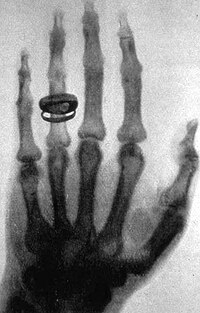
Photo from wikipedia
PurposeTo assess the diagnostic accuracy and safety of contrast-enhanced voiding urosonogram using second-generation contrast with harmonic imaging (CEVUS-HI) in detecting vesicoureteral reflux (VUR) among children.MethodsA systematic literature search was performed… Click to show full abstract
PurposeTo assess the diagnostic accuracy and safety of contrast-enhanced voiding urosonogram using second-generation contrast with harmonic imaging (CEVUS-HI) in detecting vesicoureteral reflux (VUR) among children.MethodsA systematic literature search was performed in March 2018. Relevant comparative studies from Medline, EMBASE, World of Science, Scopus, CENTRAL, WHO trial registry and Clinicaltrials.gov were identified and appraised using QUADAS-2. Diagnostic accuracy parameters were determined using VCUG as the reference standard. Adverse effects related to ultrasound contrast were summarized. The heterogeneity and inter-study variability were determined. After appropriate subgroup diagnostic accuracy parameters were investigated, summarizing receiver operator characteristics was constructed using the bivariate model meta-regression to determine the area under the curve (AUC).ResultsA total of 12 studies with low–high risk of bias, including 1917 ureteral units from 953 patients were assessed for this meta-analysis. The included studies reported no serious adverse events associated with the ultrasound contrast. The pooled diagnostic accuracy parameters of CEVUS-HI in detecting VUR amongst children were: sensitivity 90.43 (95% CI 90.36–90.50), specificity 92.82 (95% CI 92.76–92.87), the calculated (+) likelihood-ratio 12.59 (95% CI 12.49–12.68), (−) likelihood-ratio of 0.103 (95% CI 0.102–0.104) and extrapolated pooled diagnostic odds-ratio was 122.12 (95% CI 120.75–123.49). Heterogeneity with interstudy variability was noted (p < 0.0001, I-squared > 70%). The AUC was determined to be 0.965 for VUR detection.ConclusionsThe pooled diagnostic accuracy parameters from low–moderate quality of evidence have illustrated that the CEVUS-HI study has an excellent safety profile and acceptable diagnostic accuracy. It may be considered as an alternative diagnostic modality for assessment of VUR among children.
Journal Title: World Journal of Urology
Year Published: 2018
Link to full text (if available)
Share on Social Media: Sign Up to like & get
recommendations!